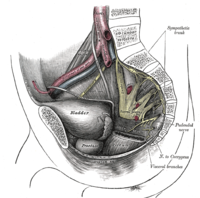
Photo from wikipedia
Background: Improvements in ultrasound diagnostic equipment and techniques can enable muscle stiffness to be measured quantitatively as muscle elasticity using ultrasound shear wave elastography (USWE), where high muscle elasticity values… Click to show full abstract
Background: Improvements in ultrasound diagnostic equipment and techniques can enable muscle stiffness to be measured quantitatively as muscle elasticity using ultrasound shear wave elastography (USWE), where high muscle elasticity values represent muscle stiffness. Purpose: To use USWE to analyze the sequential changes in muscle elasticity in the posterior shoulder before and after pitching. Study Design: Descriptive laboratory study. Methods: The authors evaluated 14 baseball players who had played in high school or college at an intermediate level. The elasticity of the supraspinatus, infraspinatus (ISP), middle trapezius, lower trapezius (LT), rhomboideus, and serratus anterior muscles of the throwing shoulder was measured using USWE at 3 time points: before, immediately after, and 24 hours after a throwing session of 100 pitches. The authors analyzed the sequential changes in the mean elasticity values of the respective muscles at the 3 time points. Results: The mean elasticity values before, immediately after, and 24 hours after throwing were as follows: supraspinatus: 32.9, 53.4, 43.8 kPa; ISP: 22.7, 44.8, 43.7 kPa; middle trapezius: 45.1, 70.3, 59.9 kPa; LT: 32.8, 45.5, 46.5 kPa; rhomboideus: 29.1, 47.5, 38.8 kPa; and serratus anterior: 19.2, 36.9, 26.5 kPa, respectively. The mean elasticity values for all tested muscles were significantly higher immediately after throwing compared with before throwing (P ≤ .0086 for all), and elasticity values in the ISP and LT remained significantly higher 24 hours after throwing compared with before throwing (P ≤ .019 for both). Conclusion: The study results indicated that pitching significantly increased ISP and LT muscle elasticity even after 24 hours.
Journal Title: Orthopaedic Journal of Sports Medicine
Year Published: 2021
Link to full text (if available)
Share on Social Media: Sign Up to like & get
recommendations!